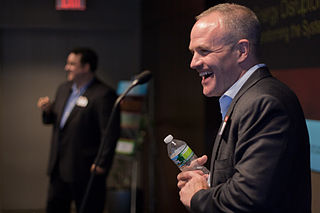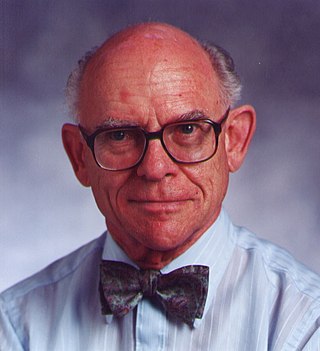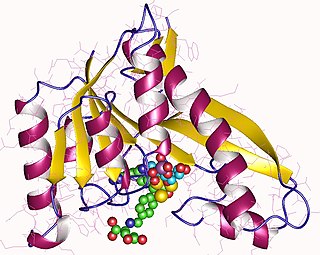Related Research Articles

In biochemistry, a ribonucleotide is a nucleotide containing ribose as its pentose component. It is considered a molecular precursor of nucleic acids. Nucleotides are the basic building blocks of DNA and RNA. Ribonucleotides themselves are basic monomeric building blocks for RNA. Deoxyribonucleotides, formed by reducing ribonucleotides with the enzyme ribonucleotide reductase (RNR), are essential building blocks for DNA. There are several differences between DNA deoxyribonucleotides and RNA ribonucleotides. Successive nucleotides are linked together via phosphodiester bonds.

Ribonucleotide reductase (RNR), also known as ribonucleoside diphosphate reductase, is an enzyme that catalyzes the formation of deoxyribonucleotides from ribonucleotides. It catalyzes this formation by removing the 2'-hydroxyl group of the ribose ring of nucleoside diphosphates. This reduction produces deoxyribonucleotides. Deoxyribonucleotides in turn are used in the synthesis of DNA. The reaction catalyzed by RNR is strictly conserved in all living organisms. Furthermore, RNR plays a critical role in regulating the total rate of DNA synthesis so that DNA to cell mass is maintained at a constant ratio during cell division and DNA repair. A somewhat unusual feature of the RNR enzyme is that it catalyzes a reaction that proceeds via a free radical mechanism of action. The substrates for RNR are ADP, GDP, CDP and UDP. dTDP is synthesized by another enzyme from dTMP.
Thioredoxin reductases are enzymes that reduce thioredoxin (Trx). Two classes of thioredoxin reductase have been identified: one class in bacteria and some eukaryotes and one in animals. In bacteria TrxR also catalyzes the reduction of glutaredoxin like proteins known as NrdH. Both classes are flavoproteins which function as homodimers. Each monomer contains a FAD prosthetic group, a NADPH binding domain, and an active site containing a redox-active disulfide bond.
Biosynthesis, i.e., chemical synthesis occurring in biological contexts, is a term most often referring to multi-step, enzyme-catalyzed processes where chemical substances absorbed as nutrients serve as enzyme substrates, with conversion by the living organism either into simpler or more complex products. Examples of biosynthetic pathways include those for the production of amino acids, lipid membrane components, and nucleotides, but also for the production of all classes of biological macromolecules, and of acetyl-coenzyme A, adenosine triphosphate, nicotinamide adenine dinucleotide and other key intermediate and transactional molecules needed for metabolism. Thus, in biosynthesis, any of an array of compounds, from simple to complex, are converted into other compounds, and so it includes both the catabolism and anabolism of complex molecules. Biosynthetic processes are often represented via charts of metabolic pathways. A particular biosynthetic pathway may be located within a single cellular organelle, while others involve enzymes that are located across an array of cellular organelles and structures.
The National Academy of Sciences Award in Chemical Sciences is awarded for innovative research in the chemical sciences that in the broadest sense contributes to a better understanding of the natural sciences and to the benefit of humanity.

Jay D. Keasling is a professor of chemical engineering and bioengineering at the University of California, Berkeley. He is also associate laboratory director for biosciences at the Lawrence Berkeley National Laboratory and chief executive officer of the Joint BioEnergy Institute. He is considered one of the foremost authorities in synthetic biology, especially in the field of metabolic engineering.

Frank Albert Cotton FRS was an American chemist. He was the W.T. Doherty-Welch Foundation Chair and Distinguished Professor of Chemistry at Texas A&M University. He authored over 1600 scientific articles. Cotton was recognized for his research on the chemistry of the transition metals.

Daniel George Nocera is an American chemist, currently the Patterson Rockwood Professor of Energy in the Department of Chemistry and Chemical Biology at Harvard University. He is a member of the National Academy of Sciences and the American Academy of Arts and Sciences. In 2006 he was described as a "major force in the field of inorganic photochemistry and photophysics". Time magazine included him in its 2009 list of the 100 most influential people.

Frances Hamilton Arnold is an American chemical engineer and Nobel Laureate. She is the Linus Pauling Professor of Chemical Engineering, Bioengineering and Biochemistry at the California Institute of Technology (Caltech). In 2018, she was awarded the Nobel Prize in Chemistry for pioneering the use of directed evolution to engineer enzymes.

JoAnne Stubbe is an American chemist best known for her work on ribonucleotide reductases, for which she was awarded the National Medal of Science in 2009. In 2017, she retired as a Professor of Chemistry and Biology at the Massachusetts Institute of Technology.

Phosphoribosylglycinamide formyltransferase (EC 2.1.2.2), also known as glycinamide ribonucleotide transformylase (GAR Tfase), is an enzyme with systematic name 10-formyltetrahydrofolate:5'-phosphoribosylglycinamide N-formyltransferase. This enzyme catalyses the following chemical reaction
Christopher J. Chang is an American chemist. He is a professor of chemistry and of molecular and cell biology at the University of California, Berkeley, where he holds the Class of 1942 Chair. Chang is also a member of the Helen Wills Neuroscience Institute, a Howard Hughes Medical Institute investigator, adjunct professor of pharmaceutical chemistry at the University of California, San Francisco, and faculty scientist at the chemical sciences division of Lawrence Berkeley Lab. He is the recipient of several awards for his research in bioinorganic chemistry, molecular and chemical biology.
Amy C. Rosenzweig is a professor of Chemistry and Molecular Biosciences at Northwestern University. She was born in 1967 in Pittsburgh, Pennsylvania. Her current research interests include structural biology and bioinorganic chemistry, metal uptake and transport, oxygen activation by metalloenzymes, and characterization of membrane protein. For her work, she has been recognized by a number of national and international awards, including the MacArthur "Genius" Award in 2003.

Professor Rudolf Konrad Allemann is a Distinguished Research Professor and Pro Vice-Chancellor International and Student Recruitment and Head of the College of Physical Sciences and Engineering at Cardiff University. Allemann joined Cardiff University in 2005, after working at the University of Birmingham, the Swiss Federal Institute of Technology ETH Zurich and the UK MRC National Institute for Medical Research at Mill Hill. He was previously Head of the School of Chemistry at Cardiff University until April 2017.

Squire Booker is an American biochemist at Penn State University. Booker directs an interdisciplinary chemistry research program related to fields of biochemistry, enzymology, protein chemistry, natural product biosynthesis, and mechanisms of radical dependent enzymes. He is an associate editor for the American Chemical Society Biochemistry Journal, is a Hughes Medical Institute Investigator, and an Eberly Distinguished Chair in Science at Penn State University.

Yimon Aye is an American chemist and molecular biologist. Currently she is a professor of chemistry & chemical biology at University of Oxford.

In biochemistry, non-heme iron proteins describe families of enzymes that utilize iron at the active site but lack heme cofactors. Iron-sulfur proteins, including those that are enzymes, are not included in this definition.
Amie Kathleen Boal is an American chemist. She is an associate professor of chemistry, biochemistry, and molecular biology at Pennsylvania State University. In 2020, Boal was the recipient of the Pfizer Award in Enzyme Chemistry from the American Chemical Society.
Kenichi Yokoyama is an enzymologist, chemical biologist, and natural product biochemist originally from Tokyo, Japan. He is an Associate Professor of Biochemistry at Duke University School of Medicine. In 2019, Yokoyama was awarded the Pfizer Award in Enzyme Chemistry from the American Chemical Society.
Aindrila Mukhopadhyay is an American scientist who is the Division Deputy of the Biological Systems and Engineering Division at Lawrence Berkeley National Laboratory. Her research involves microbial engineering for the production of biofuels. She was nominated a Fellow of the American Association for the Advancement of Science in 2022.
References
- 1 2 3 "Faculty & Research - College of Chemistry". chem.berkeley.edu.
- ↑ Chang, Michelle C. Y. (Michelle Chia-yu) (2004). Proton-coupled electron transfer in the Escherichia coli ribonucleotide reductase (Thesis). Massachusetts Institute of Technology. hdl:1721.1/30067.
- ↑ Chang, Michelle C. Y.; Yee, Cyril S.; Stubbe, JoAnne; Nocera, Daniel G. (2004-05-04). "Turning on ribonucleotide reductase by light-initiated amino acid radical generation". Proceedings of the National Academy of Sciences. 101 (18): 6882–6887. Bibcode:2004PNAS..101.6882C. doi: 10.1073/pnas.0401718101 . ISSN 0027-8424. PMC 406436 . PMID 15123822.
- ↑ Chang, Michelle C. Y.; Yee, Cyril S.; Nocera, Daniel G.; Stubbe, JoAnne (2004-12-01). "Site-Specific Replacement of a Conserved Tyrosine in Ribonucleotide Reductase with an Aniline Amino Acid: A Mechanistic Probe for a Redox-Active Tyrosine". Journal of the American Chemical Society. 126 (51): 16702–16703. doi:10.1021/ja044124d. ISSN 0002-7863. PMID 15612690.
- ↑ "Michelle Chang: A catalyst for change". The Scientist Magazine®. Retrieved 2021-05-15.
- ↑ Chang, Michelle C. Y.; Eachus, Rachel A.; Trieu, William; Ro, Dae-Kyun; Keasling, Jay D. (2007). "Engineering Escherichia coli for production of functionalized terpenoids using plant P450s". Nature Chemical Biology. 3 (5): 274–277. doi:10.1038/nchembio875. ISSN 1552-4469. PMID 17438551.
- ↑ Review, MIT Technology. "Innovator Under 35: Michelle Chang, 31". MIT Technology Review.
- ↑ CAREER award Archived 2011-09-28 at the Wayback Machine
- ↑ Agilent Early Career Award Archived 2011-09-28 at the Wayback Machine
- ↑ International Young Talents Archived 2011-09-28 at the Wayback Machine
- ↑ "UC Berkeley, College of Chemistry - News and Publications - Chang and Hammond win NIH New Innovator Awards". Archived from the original on 2011-12-09. Retrieved 2011-10-20.
- ↑ "2012 Agnes Fay Morgan Research Award, Dr Michelle Chang" (PDF). iotasigmapi.info.
- ↑ "2015 National Award Recipients". American Chemical Society. Retrieved 2016-03-20.
- ↑ "財經新聞 - PChome 新聞". PChome 新聞.
- ↑ "National magazines tout two chemists and two astronomers as top innovators in their fields" Archived 2011-06-13 at the Wayback Machine , UC Newsroom, August 22, 2008 (retrieved January 26, 2010)